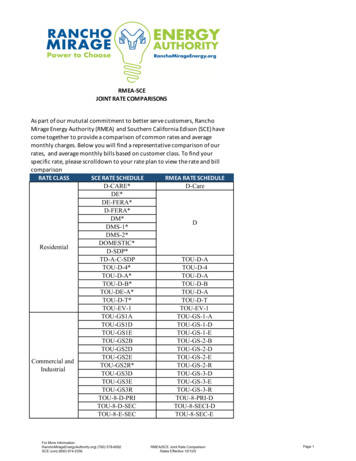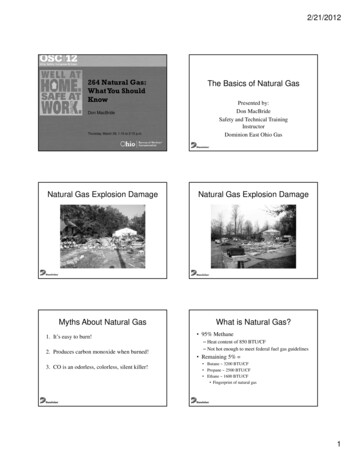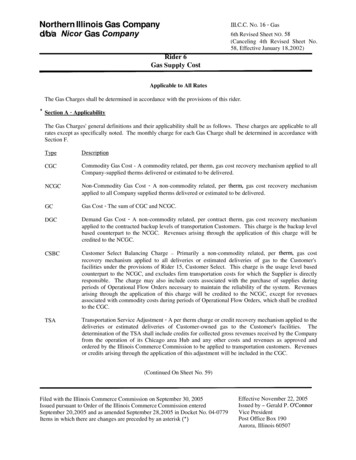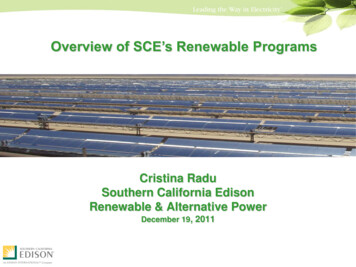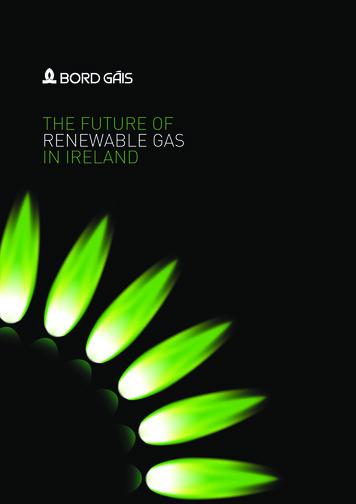
Transcription
THE FUTURE OFRENEWABLE GASIN IRELAND
DISCLAIMERThis report is based on certain publicly available information and research papers (as listed in Appendix A), Ernst & Youngproprietary data and input from the Sustainable Energy Authority of Ireland, University College Cork, the EnvironmentalProtection Agency, Forfás and Ernst & Young. We give no warranties in relation to the accuracy or completeness of anyinformation contained in this report and exclude all liability in relation to any reliance on such information.
ContentsIntroduction from CEO201. Executive summary402. Introduction603. Renewable energy in Ireland804. Biomethane resources and market potential1005. Potential of biomethane in Ireland05.1 Economics05.2 Benefits of biomethane12141506. Support structures1807. Realising the potential from biomethane2008. Conclusion and recommendations24Appendix A - References27Appendix B - Abbreviations28FUTURE OF RENEWABLE GAS IN IRELAND1
Introductionfrom CEOBord Gáis recognises the significant challenges posedby the ambitious EU and Irish renewable energy targetsin electricity, heat and transport. As an organisation, wehave clearly demonstrated our commitment to contributetowards meeting those targets via our investment in windassets and high efficiency power generation equipment.In 2008, we established a 10 million Alternative EnergyResearch and Development Fund to support research intoemerging energy-related technologies and to support anincrease in the quantity and quality of research in alternativeenergies in Ireland’s colleges. In further recognition of theimportance of renewable energy as part of a sustainablefuture for this country, Bord Gáis has commissioned thisreport ‘The Future of Renewable Gas in Ireland’.2FUTURE OF RENEWABLE GAS IN IRELAND
We believe thatRenewable Gasrepresents a significantand under-utilisedsource of renewableenergyThe report examines the productionand use of biomethane as a renewableenergy source in Ireland and itspotential contribution to assist inmeeting Ireland’s renewable energytargets. The report outlines thepotential benefits associated withdeveloping this renewable fuel sourceas well as the barriers that must beovercome to make renewable gas areality.We believe that renewable gasrepresents a significant and underutilised source of renewable energy inIreland and could make a significantcontribution to Ireland’s renewableenergy and waste objectives in thefuture. The production of grid qualitybiomethane or renewable gas canplay a vital role in helping Ireland toattain its renewable energy targets, inaddition to a variety of other benefitsoutlined in the report. The fact thatbiomethane can be transportedusing the readily available naturalgas infrastructure, to over 640,000homes and businesses throughoutthe country, represents a significantadvantage. Many other countries inEurope have recognised the valueof renewable gas and are puttingthe necessary structures in place tosupport the industry e.g. Germany andSweden.Undoubtedly, there are obstacles tomaking renewable gas a viable energysource in Ireland. However we believeif the necessary parties work together,these barriers can be overcome ina relatively short timeframe. Weare willing to work with the relevantauthorities to ensure that thenecessary structures are put in place.We welcome the support of industry,the Sustainable Energy Authority ofIreland (SEAI), the EnvironmentalProtection Agency (EPA) and otherrelevant parties in the publicationof this report and we look forwardto working with all policy makers inthe development of a renewable gasindustry in Ireland.John Mullins,CEO, Bord GáisFUTURE OF RENEWABLE GAS IN IRELAND3
01.Executive summaryThe EU and the Irish Government have set bold renewableenergy, environmental and waste management targets forIreland, but renewable energy currently accounts for onlyaround 4% of Ireland’s total gross final energy demand.Obviously something needs to be done to address thisshortfall. The EU has highlighted the sustainability ofrenewable gas systems and has encouraged Member Statesto take measures to support the wider use of renewablegas. In Ireland, there is a large resource available for theproduction of renewable gas and, if captured and utilisedefficiently, it could represent a significant opportunity tohelp achieve these challenging renewable energy targets.4FUTURE OF RENEWABLE GAS IN IRELAND
CAPTURING THISRESOURCE WOULD BE ACONSIDERABLE STEP INADDRESSING IRELAND’SCHALLENGING RENEWABLEENERGY TARGETSThis paper, commissioned by Bord Gáis, investigatesthe potential for producing biomethane in Ireland,assesses its potential contribution to achievingIreland’s renewable energy targets and includes aqualitative discussion on the potential benefits andbarriers to using biomethane as a source of heatingand transport fuel in Ireland. The report highlightsthat energy from biomethane has the potentialto contribute significantly to Ireland’s renewableenergy targets. In particular biomethane couldgreatly assist Ireland in meeting the EU targetsfor thermal energy from renewables (RES-H) andtransport fuel from renewables (RES-T).Biogas is produced when feedstocks, such asorganic wastes (agricultural and municipal), andenergy crops, such as grass silage, are convertedinto biogas using anaerobic digestion technology.The ‘raw’ biogas can be cleaned and upgraded intobiomethane (renewable gas) and injected into thenational gas grid to be used as a heating fuel inhomes and businesses. A conservative estimateof the potential biomethane resource in Ireland is0.4 billion m3/a or 7.5% of the national gas demandrequirement (the equivalent of heating 300,000homes each year). Capturing this resource wouldbe a considerable step in addressing Ireland’schallenging renewable energy targets and helpreduce the country’s dependency on energy imports.Biomethane production could also provide anenvironmentally sound waste management option,helping Ireland to meet EU Landfill Directiverequirements, thereby reducing the overall costof waste management in Ireland today. Otherbenefits from the development of a biomethaneinfrastructure might include income and job securityfor farmers and job creation in the constructionand operation of biomethane plants. A biomethaneinfrastructure could make a significant contributionto the ‘green tech’ sector in line with Ireland’sstrategy to create sustainable knowledge-drivenindustries.Undoubtedly work still needs to be done to makebiomethane a viable energy option for Ireland.However, most of the obstacles identified in thisreport could be resolved relatively quickly with thesupport of Government and the relevant regulatorybodies. The following recommendations shouldbe considered by policy makers to encouragebiomethane production in Ireland: Set national targets for a proportion of gasdemand to be met from biomethane. Review the Renewable Energy Feed-in Tariff(REFIT) to support biomethane fed directlyinto the natural gas grid. The new tariff couldbe in line with the support structure used inGermany. Implement regulatory conditions to allowbiomethane producers to inject biomethanedirectly into the gas grid and adopt suitablestandards that will regulate the quality ofbiomethane that may be injected into thegas grid. Such standards will deal with gasspecifications such as chemical compositionand energy content. Implement new support structures foragriculture to provide an incentive forfarmers to produce feedstock for biomethaneproduction. Align renewable energy and wastemanagement policies to deliver certaintyaround feedstock supply over the life of thebiomethane plant. More funding for research, developmentand demonstration of renewable gastechnologies, building upon the existingexpertise in biotechnology and informationtechnology.FUTURE OF RENEWABLE GAS IN IRELAND5
02.IntroductionIreland has enjoyed substantial economic growth inthe past 15 to 20 years and this has been accompaniedby commensurate growth in energy demand.6FUTURE OF RENEWABLE GAS IN IRELAND
there is a need to findalternative, sustainableand renewable energysourcesThe above-inflationary growth in total primary energyconsumption (total growth of 72% from 1991 to 2008) hasmagnified some of the existing characteristics of the Irishenergy system – high energy imports and growing greenhousegas (GHG) emissions.1-2An increased reliance on gas in the economy,Current estimates3 indicate that the near termthe absence of sufficient domestic reserves,demand for gas in the power, residential,concerns for the environment and an increase incommercial and industrial sectors is expected toelectricity and gas prices have driven the need toincrease by about 6,000GWh by 2020 compared tofind alternative, sustainable and renewable energythe current level of 60,000GWh. Figure 1 shows thesources.forecast gas demand up to ANNUAL GAS DEMAND (PJ)ANNUAL GAS DEMAND (GWh)Figure 1: Gas demand projection in the Republic of /182018/192019/20180Source: Annual gas demand forecasts up to 2014/15 were provided by Gaslink. The annual change in gas demand after 2014/15 was calculated using the averageannual increase/decrease in gas demand between 2008/09 to 2014/15.Figure 2: Energy use in Irelandby mode of application 2008Heating 41%Electricity 17%FUTURE OF RENEWABLE GAS IN IRELAND7
03.Renewable energy in IrelandThe White Paper published in March 2007 sets outthe Government’s Energy Policy for 2007 to 2020.8FUTURE OF RENEWABLE GAS IN IRELAND
renewable energy hasgrown considerably inabsolute terms since themid-1990sThe Government has set targets for:Ireland is making progress in relation to itsrenewable energy sourced electricity (RES-E) target:generated from renewable sources by 201068000and2020 respectively. The 2020 target wassubsequentlyextended to 40% in the Carbon66000Budget of October 2008.464000 A minimum of 5% and 12% renewable62000energyshare of the heating sector for 20105and2020respectively.60000from renewable energy sources, up from 4.4% in2502003.240By 2009, wind accounted for 11% of electricity inIreland.7 In May 2008, the Economic and SocialResearch Institute (ESRI) stated that the amount ofelectricity generated from wind could reach 30% by Renewableresources to contribute at least5800010% of all transport fuel by 2020.2020,8 making a significant contribution to the new230220ANNUAL GAS DEMAND (PJ)ANNUAL GAS DEMAND (GWh)Figure1: Gasdemandprojectionin the Republic11.8% of total electricity consumed in 2009 came At least15%and 33%of electricityto be of Ireland21040% RES-E target under the Carbon Budget set in56000200October 2008.54000Renewable energy has been contributing19052000Figure 2 shows the final energy use in Irelandapproximately 2% of Ireland’s energy supply since500001990.In 2008renewable4%2008/092009/10 sources2010/11 contributed2011/122012/13brokendown2015/16by application.Theshareof energy2013/142014/152016/172017/182018/192019/20of Ireland’s gross final energy use. The significantused for heating and transport has historically beenincrease in energy demand over that time masks theoverlooked by renewable energy policy, despitefact that renewable energy has grown considerablyfinal energy demand for both heating and transportin absolute terms since the mid-1990s. Thein Ireland being significantly higher than that forcontribution from renewable energy grew by overelectricity.9 By 2008, however, only 3.6% of thermal247% (7.1% per annum) between 1990 and 2008.energy was generated from renewable sources6180(compared with 11.9% for electricity).10Figure 2: Energy use in Irelandby mode of application 2008Heating 41%Electricity 17%Transport 42%Source: Energy in Ireland 1990-2008, Energy Policy Statistical Support Unit,the Sustainable Energy Authority of Ireland (SEAI).FUTURE OF RENEWABLE GAS IN IRELAND9
04.Biomethane resources andmarket potentialBiogas production occurs when biomass is broken downinto simpler chemical components, typically using anaerobicdigestion (AD) technology.10FUTURE OF RENEWABLE GAS IN IRELAND
Transport 42%Ireland has significantunexploited potentialfor biomass in the formof agricultural land andrecycled wasteAD technology involves a natural process ofFigure 3: Uses of biogasdecomposition in the absence of oxygen. It is aproven technology that has been in use sinceFeedstock1895 when biogas was recovered from a sewagetreatment plant and used to fuel street lamps inExeter, England.11 The decomposition processproduces a ‘raw’ biogas, comprising methaneBiogasOnsite CHPand carbon dioxide, in addition to a semi-soliddigestate residue product. Raw biogas can beused on-site to produce heat and electricity orBiomethaneupgraded to biomethane and injected into thenatural gas network, or used as a transport fuel.12Biogas upgrading involves cleaning and purifyingTransportthe raw biogas to meet a specification akin tonatural gas. The main purpose of the upgrading isto remove gases such as carbon dioxide (CO2) andGridhydrogen sulphide (H2S), and eliminate or reduceHeatcontaminants. Biomethane injected into the gridcan generate significantly more energy off-sitewhere its use can be optimised by using it for heat,ElectricityCombined Heat and Power (CHP), or transport fuelrather than on-site electricity generation only.13Figure 3 illustrates the various uses of biogas.Ireland has significant unexploited potential forbiomass in the form of agricultural land andrecycledagriculturalandFigure 4:wasteFossilfromfuelmunicipal,based naturalgas displacementby biogasindustrial sources. In 2007, Ireland produced aboutANNUAL GAS DEMAND (GWh)68000gas demand, partially displaced by biogas (GWh)40 milliontonnesTotalof biodegradablewastesBiogas produced (GW66000(i.e. slurry, slaughter waste and organic household64000waste) suitable for anaerobic digestion.14 In62000addition, Ireland has significant unexploited60000resource potential in the form of grass, with5800091% of agricultural land, or 3.9 million hectares,56000being used to grow this potential energy 12/132013/142014/15FUTURE OF RENEWABLE GAS IN IRELAND2015/161120
05.Potential of biomethanein IrelandResearch, sponsored by Bord Gáis, has been carried outon the availability of different feedstock for anaerobicdigestion at University College Cork.15 This analysis providedboth a ‘technical’ and a ‘baseline’ potential for eachfeedstock in 2020.12FUTURE OF RENEWABLE GAS IN IRELAND
BiomethaneTransportGridbiomethane could make asignificant contributionto Ireland’srenewableElectricityenergy and wasteobjectives in the futureHeat68000Total gas demand, partially displaced by biogas (GWh)250Biogas produced UAL GAS DEMAND (PJ)ANNUAL GAS DEMAND (GWh)Figure 4: Fossil fuel based natural gas displacement by 2018/192019/20Source: Annual gas demand forecasts up to 2014/15 were provided by Gaslink. The annual change in gas demand after 2014/15 was calculated using theaverage annual increase/decrease in gas demand between 2008/09 to 2014/15.The technical potential represents the maximumvolume of biomethane that could be produced if theentire quantity of available feedstock in Ireland wereused to produce biomethane. The baseline potentialconsiders a scenario where a realistic proportion ofthe feedstock is diverted to biomethane production.This is based on 5% of cattle, pig and sheep slurry,75% of poultry slurry, 50% of slaughter waste and25% of the organic fraction of municipal solid waste(OFMSW).16 Surplus grass in the baseline scenarioequates to approximately 100,000 ha.17 The resultsof this analysis are set out in Table 1.Under the technical scenario there is the potentialto meet 33.2% of Ireland’s current natural gasdemand, or 11.4% of total final energy demandwith biomethane by 2020. Our mandatory targetunder EU Directive 2009/28/EC is to achieve 16%renewable energy penetration by 2020. Under thebaseline scenario there is the potential to meet7.5% of Ireland’s current natural gas demand, asshown in Figure 4, or 2.6% of total final energydemand with biomethane by 2020. This is equivalentto 7.4% of Ireland’s thermal energy demand in2020 and indicates that biomethane could makea significant contribution to Ireland’s renewableenergy and waste objectives in the future.Table 1: Total energy potential of waste and surplus grass in Ireland for 2020Technical potentialBiomethaneEnergyeSourceMm3/aAgricultural slurry423.8PJaBaseline 15.6b0.57OFMSW61.7Slaughter waste37.4c1.3718.60.68Surplus 5.03% of total current Irish gas demand33.2%7.5%% of 2020 final energy demand in white paper scenario11.4%2.6%Source: Adapted Singh A, Smyth BM, Murphy JD, Renewable and Sustainable Energy Review, Volume 14, Issue 1, January 2010, Pages 277-288.Notes:a. 32,000,000 tonnes agricultural slurry x 12.8m3 methane (CH4) per tonne x 1/0.97 423.8 Mm3 biomethane per annum (with 97% CH4 content).b. 870,000 tonnes OFMSW x 25% recoverable x 69 m3 CH4 per tonne x 1/0.97 15.6 Mm3 biomethane per annum.c. 420,000 tonnes slaughter waste x 86 m3 CH4 per tonne x 1/0.97 37.4 Mm3 biomethane per annum.d. 97,500 hectares x 3,240 m3 CH4 per hectare x 1/0.97 325.7 Mm3 biomethane per annum.e. Conversion assumes biomethane has an energy content of 36.8 MJ/Mm3FUTURE OF RENEWABLE GAS IN IRELAND13
05.05.1 EconomicsThe production of biomethane requiresUniversity College Cork indicates that the cost ofsignificant capital expenditure, as with all energyheating buildings already connected to the naturalinfrastructure, and relies on a long-term revenuegas network with a blended fuel (12% biomethane,stream to make a return on this investment. Where88% natural gas) may not be significantly morebiogas is used in electricity production, theseexpensive than natural gas. The high cost offacilities benefit from a feed-in tariff under Ireland’sproducing biomethane is buffered by its relativelyREFIT scheme. Biomethane, however, would notlow percentage in the blend. This is advantageousdirectly benefit from this tariff, relying instead on theto city buildings which are already connected tosale of the gas at market rates (such as wholesalethe grid and would otherwise have to install agas prices) and possibly gate fees (fees which wouldnew renewable heating system to meet the 2020be paid by feedstock suppliers).renewable energy target of 12%. Indeed, biomethaneproduced using feedstocks which do offer a gate feeThe natural gas infrastructure is extensive,(OFMSW and slaughter waste for example) could beproviding energy to over 640,000 domestic, industrialless expensive, possibly resulting in a net income toand commercial customers in Ireland. The fact thatthe AD plant developer, before other revenues arethe distribution system is already built representstaken into account.a significant advantage to biomethane over otherrenewable heat technologies.There is an increase in the number of plantsproducing biomethane for injection into the14The cost of producing biomethane from farm-basednatural gas grid, with Austria, Germany, Sweden,feedstocks (such as slurries, which do not attractSwitzerland and the Netherlands among thegate fees, and grass, which requires purchase)leading markets in this area. The work by the ERIranges from around 10c/kWh to 20c/kWh dependingdemonstrates that this technology would be largelyon the feedstock, the scale of operation and thedependent on financial support, at least until thetechnology provided. Research carried out in 2008technology is established and until costs start to fallby the Environmental Research Institute (ERI) atas knowledge gained impacts on the sector.FUTURE OF RENEWABLE GAS IN IRELAND
One of the key benefitsassociated withbiomethane is that it canbe transported usingconventional natural gasinfrastructure05.2 Benefits ofbiomethaneThermal energyWaste managementIreland’s White Paper on Energy in 2007 setWhile the increase in municipal recycling ratesrespective targets of 33% renewable electricity andhas been significant, Ireland still has a waste12% renewable heat by 2020 (although the RES-management infrastructure that relies heavily onE target is now 40% since the Carbon Budget inlandfill.18 The EU Landfill Directive stipulates that2008). Support mechanisms introduced by the Irishby 2016, Ireland can only landfill 35% of the levelGovernment to date have resulted in a steady riseof biodegradable municipal waste produced inin the deployment of wind energy, from 117MW in1995.19 In order to meet the EU Landfill Directive,2000 to 1,264MW in February 2010. Using similarIreland needs to deliver waste infrastructure toincentive mechanisms to help overcome some ofdivert 900,000 tonnes per annum of biodegradablethe financial barriers associated with biomethanemunicipal waste from landfill by 2016. Biomethaneproduction, Ireland could make a substantialplants offer local authorities and the private sectorcontribution to the RES-H target using this sourcea useful alternative to landfill while providing aof renewable energy. Under the baseline scenariorenewable source of energy in the form of electricity,of this study, Ireland could produce 15PJ ofheat or transport fuel.biomethane per annum, equivalent to around 7%of the White Paper forecast for thermal energy inCarbon abatement and sustainability2020 (202PJ), or 44% of residential gas consumptionIreland’s target under the Kyoto Protocol is to limit(34PJ). Under the technical scenario biomethaneannual greenhouse gas emissions to 13% abovecould meet 33% of Ireland’s overall projected1990 levels over the period 2008 to 2012. Ireland’sheat demand and 200% of projected domestic gasCO2 target for the period 2008 to 2012, as set byconsumption. Biomethane could therefore play athe Kyoto Protocol, was contravened as far back asmajor role in meeting the 12% RES-H target.1997. By 2007 annual greenhouse gas emissionswere 24.6% above 1990 levels.20 Furthermore,One of the key benefits associated with biomethanethe EU Burden-sharing Proposals on Energyis that it can be transported using conventionaland Climate Change require Ireland to reduce itsnatural gas infrastructure. Biomethane couldgreenhouse gas emissions by 20% by 2020, basedbe supplied to end customers with no change toon 2005 emissions. Using organic waste and otherexisting infrastructure or metering equipment,agricultural feedstocks to create biomethane is aavoiding the installation of district heating systemssustainable, renewable waste-to-energy solution,or wood pellet/chip boilers and providing renewablewhich reduces greenhouse gas emissions fromheat to buildings connected to the gas grid.landfill and from fossil fuel. In the EU RenewableEnergy Directive (2009/28/EC) biofuels producedfrom residues and lignocellulosic material (suchas grass) are awarded ‘double credit’ whenestablishing compliance with the 2020 target of 10%renewable energy in transport.21FUTURE OF RENEWABLE GAS IN IRELAND15
05.05.2 Benefits ofbiomethane continuedSecurity of supplyEconomic development and innovationSecurity of energy supply is one of the mostThe Government’s Strategy for Science, Technologyimportant macroeconomic and strategic issuesand Innovation outlines a vision for Ireland in 2013for any country, and even more so for an islandas a country internationally renowned for excellencenation such as Ireland. Over the last twenty yearsin research and innovation. Biomethane offers anthe energy landscape in Ireland has changedopportunity for the development of innovative newdramatically. In 1990 domestic energy productiontechnologies, processes and skills, which could beaccounted for 32% of Ireland’s energy requirements.used for further inward investment and export toHowever, import dependency has grown significantlyother renewable energy markets. Uptake could bedue to the decline in natural gas production,stimulated through demonstration projects involvingcoupled with the increase in energy use and, bypublic and private sector organisations, with a2007, only 11% of Ireland’s energy consumptionview to tackling a number of issues including thewas sourced from domestic production. Anyproduction of low-carbon energy and the treatmentdisruption to energy imports would consequentlyof biological waste at a local level. The developmenthave a significant impact on the Irish economy.of biomethane infrastructure could also generateThe production of biomethane from anaerobicsignificant employment opportunities in terms ofdigestion could provide Ireland with an indigenousplant construction, operation and indirect services,and reliable energy source amounting to 33% ofconsequently creating an estimated 5,000 indirectdomestic natural gas demand, helping to reducejobs.the dependency on natural gas imported from theUK and mainland Europe. An indigenous supplyAssuming a plant size of 50,000 tonnes per annum,of biomethane could also provide some protectionwhich would provide sufficient economies of scalefrom volatile international energy prices.in upgrading biogas to biomethane, Ireland wouldrequire 183 rural biomethane facilities to processthe quantities of grass and slurry feedstocks asdescribed under the baseline scenario(Table 1). A rural digester of this size would,however, most likely be based on the CentralisedAnaerobic Digestion (CAD) system and wouldtherefore require a large collection radius.16FUTURE OF RENEWABLE GAS IN IRELAND
Biomethane offers anopportunity for thedevelopment of innovativenew technologiesSimilarly, a further eight plants of 50,000 tonnesthree operational employees (plant manager/labper annum each could process the quantitiestechnician and two loader drivers), presentingof slaughter waste and OFMSW as per thelimited direct employment opportunities. Howeverbaseline scenario. The total investment cost forthe indirect impacts could be greater, particularlythe number of plants described here and set outif Irish developers, contractors and technologyin Table 2 would be of the order of 1.4 billion.companies were established or expanded to buildA typical biomethane plant may only requirethis new capacity.Table 2: Digesters proposed for Ireland in 2020Digester typeNumberFeedstock treatedTotal feedstockCapitalinvestment (M )Rural183 * 7m 1,281m50,000 t/a:9.15 M t/a:18329,000 t/a grass (530 ha)5.3 M t/a grass (97 k ha)21,000 t/a slurry3.87 M t/a slurrySlaughter452,000 t/a208,000 t/a4 * 15m 60mMunicipal454,500 t/a218,000 t/a4 * 20m 80mSource: Singh A, Smyth BM, Murphy JD, Renewable and Sustainable Energy Reviews, Volume 14, Issue 1, January 2010, Pages 277-288.FUTURE OF RENEWABLE GAS IN IRELAND17
06.Support structuresThere are clear benefits to increasing the level ofbiomethane produced in Ireland in terms of energy security,waste management and carbon abatement.18FUTURE OF RENEWABLE GAS IN IRELAND
Some support mechanismsare already in place toassist the development ofbioenergy in IrelandLike other renewable energy technologies, therate of deployment of biomethane will remain slowunless adequate returns are achievable by investors,commensurate with the risk taken in investingin this technology. Some support mechanismsare already in place to assist the development ofbioenergy in Ireland, including: Renewable Energy Feed-in Tariff (REFIT)of 12c/kWh for electricity produced byanaerobic digestion. The Sustainable Energy Authority of Ireland(SEAI) grant aid for biomass CHP/AnaerobicDigestion (AD) CHP providing a capital grantof up to 30% of the initial capital costs. Bioenergy Establishment Scheme whichprovides grants to farmers interested ingrowing miscanthus and willow. Energy Crops Scheme which offers growers 45/ha for areas sown under energy cropsunder the Single Payment Scheme. Government published Bioenergy ActionPlan for Ireland which put in place systemsto encourage the use of bioenergy in publicbuildings. Renewable heat deployment programme(ReHEAT) provides grants for wood chip/pellet boilers, solar thermal systems andheat pumps. The Greener Homes Scheme (GHS) providesassistance to homeowners to purchasenew renewable energy heating systems forexisting homes.These support mechanisms do not provide a directfinancial incentive to increase the use of biogas foruses other than CHP production. For this reason,biogas is not currently upgraded to natural gasquality since there is no economic incentive to doso. If there was an equivalent support mechanism inplace for the production of grid quality biomethane,aligned with a supporting regulatory framework,this could provide the impetus to start a renewablegas industry in Ireland.FUTURE OF RENEWABLE GAS IN IRELAND19
07.Realising the potential frombiomethaneThe economic viability of anaerobic digestion projects iscurrently driven by a combination of gate fees received andincentives provided by the Government under the REFITscheme for the electricity produced.20FUTURE OF RENEWABLE GAS IN IRELAND
Approximately 91% ofagricultural land inIreland is under grassand is used for grazingcattle and sheep orproducing silage.There is currently no equivalent incentivefor biomethane used as a source of heat ortransport fuel. Such a tariff would be relativelystraightforward to introduce, if based at thepoint of injection into the gas grid. Althoughsome form of accreditation and monitoringwould be required, particularly where the gasis only used off-grid (in rural locations, forexample). Financial incentives alone will notresult in high rates of deployment of anaerobicdigestion projects as many of the barriersto be overcome are non-financial issues asdescribed below.Feedstock supplyA key issue when
FUTURE OF RENEWABLE GAS IN IRELAND 1 CONTENTS Introduction from CEO 2 01. Executive summary 4 02. Introduction 6 03. Renewable energy in Ireland 8 04. Biomethane resources and market potential 10 05. Potential of biomethane in Ireland 12 05.1 Economics 14 05.2 Benefits of biomethane 15





